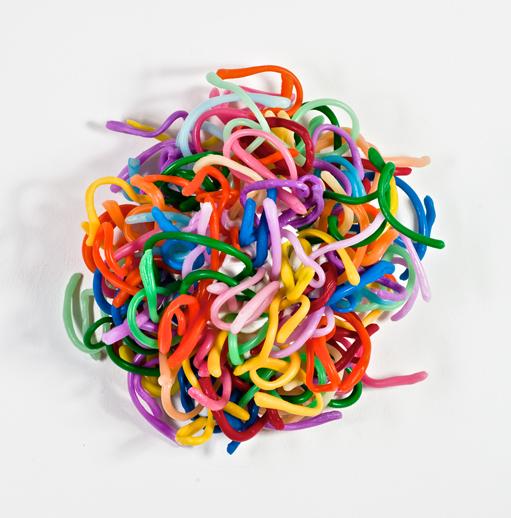Yet Angi is more inspired by the microscopic and gigantic. ‘I am looking for forms which do not yet exist’ he says. In other words, he is keen to exploit the poetic potential of his materials, and he is able to imagine what the most powerful microscopes and telescopes have yet to reveal about organic matter, atoms or distant galaxies.
Plastic Invasor resembles an extra-terrestrial spider or insect; its scale is impossible to determine. Is it microscopic? Gigantic? The multicoloured wires, shooting off in every direction, create a feeling of chaos – then we notice there is movement bringing the sculpture to life, as if each juddering tentacle helps the creature to move like an octopus. The term Invasor conveys the idea of a threat… of our world being colonized by unknown creatures.
His relief-painting Nanoland evokes the electronic context of computer circuits. This monumental work is divided into a parallel and perpendicular grid, recalling the cardo and decumanus of Roman street-plans. Nanoland looks like the model of a futuristic city, albeit one with organic buildings. We think of the film Tron, with its computer-programmer sucked into the virtual world he helped create. Alex Angi’s curious sculptures, made from recycled plastic, have a powerful appeal to the imagination. Some resemble flowers – tropical orchids which look too good to be true, concealing their poison beneath their brightly coloured appearance. They can also evoke jewellery; while a their haptic qualities bring them close to the world of childhood (plasticine or infants’ toys, say). And then, they sometimes resemble marzipan, as if they were good to taste!
With their lozenge-shaped pictures, slightly curved surfaces and intricate network of coloured plastic wires, Angi’s Multivers series explores the idea of a parallel world. In quantum physics, the term multiverse (from ‘multi-universe’) refers to multiple possible universes co-existing in different parallel dimensions. One might imagine that each wire in an Angi picture portrays a channel of Space and Time, intersecting with other universes while continuing to follow its own path.
Finally, Turbo Jungle returns to the organic field: a psychedelic pile-up evoking a spine or the structure of the DNA double-helix – DNA gone beserk, with jabbering ‘languages’ bringing to mind the Tower of Babel and nations’ inability to communicate with each other… notably about pollution, and how to tackle it.
By recycling plastic into works of art – that’s one way, suggests Alex Angi.







Comments 0
Say something